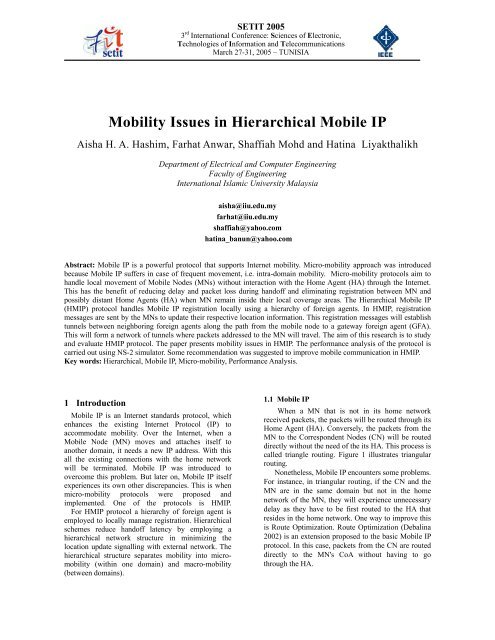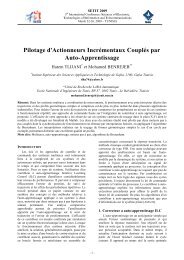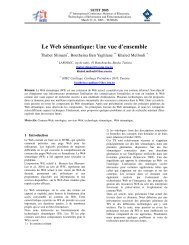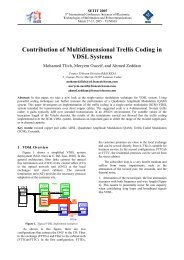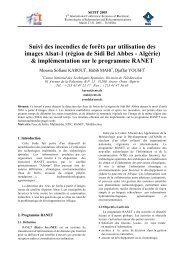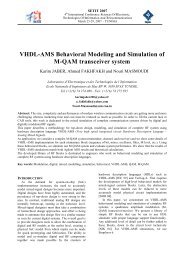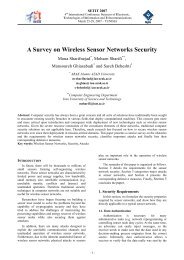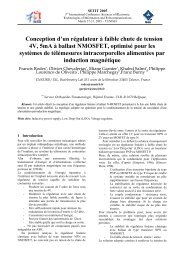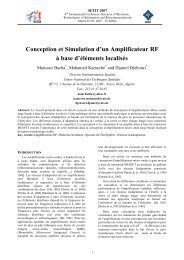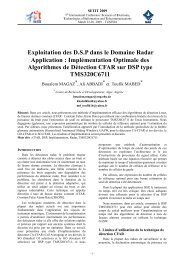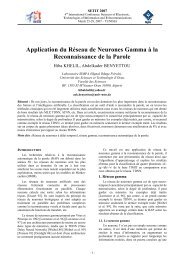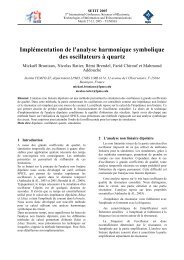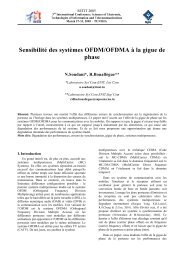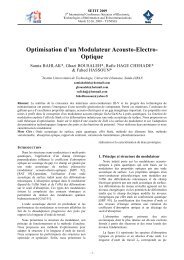Mobility Issues in Hierarchical Mobile IP
Mobility Issues in Hierarchical Mobile IP
Mobility Issues in Hierarchical Mobile IP
Create successful ePaper yourself
Turn your PDF publications into a flip-book with our unique Google optimized e-Paper software.
SETIT 2005<br />
3 rd International Conference: Sciences of Electronic,<br />
Technologies of Information and Telecommunications<br />
March 27-31, 2005 – TUNISIA<br />
<strong>Mobility</strong> <strong>Issues</strong> <strong>in</strong> <strong>Hierarchical</strong> <strong>Mobile</strong> <strong>IP</strong><br />
Aisha H. A. Hashim, Farhat Anwar, Shaffiah Mohd and Hat<strong>in</strong>a Liyakthalikh<br />
Department of Electrical and Computer Eng<strong>in</strong>eer<strong>in</strong>g<br />
Faculty of Eng<strong>in</strong>eer<strong>in</strong>g<br />
International Islamic University Malaysia<br />
aisha@iiu.edu.my<br />
farhat@iiu.edu.my<br />
shaffiah@yahoo.com<br />
hat<strong>in</strong>a_banun@yahoo.com<br />
Abstract: <strong>Mobile</strong> <strong>IP</strong> is a powerful protocol that supports Internet mobility. Micro-mobility approach was <strong>in</strong>troduced<br />
because <strong>Mobile</strong> <strong>IP</strong> suffers <strong>in</strong> case of frequent movement, i.e. <strong>in</strong>tra-doma<strong>in</strong> mobility. Micro-mobility protocols aim to<br />
handle local movement of <strong>Mobile</strong> Nodes (MNs) without <strong>in</strong>teraction with the Home Agent (HA) through the Internet.<br />
This has the benefit of reduc<strong>in</strong>g delay and packet loss dur<strong>in</strong>g handoff and elim<strong>in</strong>at<strong>in</strong>g registration between MN and<br />
possibly distant Home Agents (HA) when MN rema<strong>in</strong> <strong>in</strong>side their local coverage areas. The <strong>Hierarchical</strong> <strong>Mobile</strong> <strong>IP</strong><br />
(HM<strong>IP</strong>) protocol handles <strong>Mobile</strong> <strong>IP</strong> registration locally us<strong>in</strong>g a hierarchy of foreign agents. In HM<strong>IP</strong>, registration<br />
messages are sent by the MNs to update their respective location <strong>in</strong>formation. This registration messages will establish<br />
tunnels between neighbor<strong>in</strong>g foreign agents along the path from the mobile node to a gateway foreign agent (GFA).<br />
This will form a network of tunnels where packets addressed to the MN will travel. The aim of this research is to study<br />
and evaluate HM<strong>IP</strong> protocol. The paper presents mobility issues <strong>in</strong> HM<strong>IP</strong>. The performance analysis of the protocol is<br />
carried out us<strong>in</strong>g NS-2 simulator. Some recommendation was suggested to improve mobile communication <strong>in</strong> HM<strong>IP</strong>.<br />
Key words: <strong>Hierarchical</strong>, <strong>Mobile</strong> <strong>IP</strong>, Micro-mobility, Performance Analysis.<br />
1 Introduction<br />
<strong>Mobile</strong> <strong>IP</strong> is an Internet standards protocol, which<br />
enhances the exist<strong>in</strong>g Internet Protocol (<strong>IP</strong>) to<br />
accommodate mobility. Over the Internet, when a<br />
<strong>Mobile</strong> Node (MN) moves and attaches itself to<br />
another doma<strong>in</strong>, it needs a new <strong>IP</strong> address. With this<br />
all the exist<strong>in</strong>g connections with the home network<br />
will be term<strong>in</strong>ated. <strong>Mobile</strong> <strong>IP</strong> was <strong>in</strong>troduced to<br />
overcome this problem. But later on, <strong>Mobile</strong> <strong>IP</strong> itself<br />
experiences its own other discrepancies. This is when<br />
micro-mobility protocols were proposed and<br />
implemented. One of the protocols is HM<strong>IP</strong>.<br />
For HM<strong>IP</strong> protocol a hierarchy of foreign agent is<br />
employed to locally manage registration. <strong>Hierarchical</strong><br />
schemes reduce handoff latency by employ<strong>in</strong>g a<br />
hierarchical network structure <strong>in</strong> m<strong>in</strong>imiz<strong>in</strong>g the<br />
location update signall<strong>in</strong>g with external network. The<br />
hierarchical structure separates mobility <strong>in</strong>to micromobility<br />
(with<strong>in</strong> one doma<strong>in</strong>) and macro-mobility<br />
(between doma<strong>in</strong>s).<br />
1.1 <strong>Mobile</strong> <strong>IP</strong><br />
When a MN that is not <strong>in</strong> its home network<br />
received packets, the packets will be routed through its<br />
Home Agent (HA). Conversely, the packets from the<br />
MN to the Correspondent Nodes (CN) will be routed<br />
directly without the need of the its HA. This process is<br />
called triangle rout<strong>in</strong>g. Figure 1 illustrates triangular<br />
rout<strong>in</strong>g.<br />
Nonetheless, <strong>Mobile</strong> <strong>IP</strong> encounters some problems.<br />
For <strong>in</strong>stance, <strong>in</strong> triangular rout<strong>in</strong>g, if the CN and the<br />
MN are <strong>in</strong> the same doma<strong>in</strong> but not <strong>in</strong> the home<br />
network of the MN, they will experience unnecessary<br />
delay as they have to be first routed to the HA that<br />
resides <strong>in</strong> the home network. One way to improve this<br />
is Route Optimization. Route Optimization (Debal<strong>in</strong>a<br />
2002) is an extension proposed to the basic <strong>Mobile</strong> <strong>IP</strong><br />
protocol. In this case, packets from the CN are routed<br />
directly to the MN's CoA without hav<strong>in</strong>g to go<br />
through the HA.
SETIT2005<br />
network sitt<strong>in</strong>g on top of <strong>IP</strong>. Tunnels connect the<br />
gateway foreign agent to other foreign agents at the<br />
network access po<strong>in</strong>ts (Chew 2002).<br />
Figure 1. Triangular Rout<strong>in</strong>g<br />
Due to frequent change of MN’s po<strong>in</strong>t-ofattachment,<br />
a few disadvantages occurred. The<br />
disadvantages are delay <strong>in</strong> handoff, packet loss and<br />
signal<strong>in</strong>g load. Therefore HM<strong>IP</strong> protocol is proposed.<br />
1.2 <strong>Hierarchical</strong> <strong>Mobile</strong> <strong>IP</strong><br />
A hierarchical solution is more appropriate to the<br />
Internet as it differentiates local mobility from global<br />
mobility. The <strong>Hierarchical</strong> <strong>Mobile</strong> <strong>IP</strong> protocol<br />
employs a hierarchy of FAs to locally handle <strong>Mobile</strong><br />
<strong>IP</strong> registration. Typically one level of hierarchy is<br />
considered where all foreign agents are connected to<br />
the gateway foreign agent (GFA). Figure 2 expla<strong>in</strong>s<br />
the architecture of <strong>Hierarchical</strong> <strong>Mobile</strong> <strong>IP</strong>.<br />
In this case, direct tunnels connect the gateway<br />
foreign agent to foreign agents that are located at<br />
access po<strong>in</strong>ts. Pag<strong>in</strong>g extensions (Haver<strong>in</strong>en & al<br />
2000) for <strong>Hierarchical</strong> <strong>Mobile</strong> <strong>IP</strong> are presented <strong>in</strong><br />
allow<strong>in</strong>g idle mobile nodes to operate <strong>in</strong> a power<br />
sav<strong>in</strong>g mode while located with<strong>in</strong> a pag<strong>in</strong>g area. The<br />
location of mobile hosts is known by home agents and<br />
is represented by pag<strong>in</strong>g areas. After receiv<strong>in</strong>g a<br />
packet addressed to a mobile host located <strong>in</strong> a foreign<br />
network, the home agent tunnels the packet to the<br />
pag<strong>in</strong>g foreign agent, which then pages the mobile<br />
host to re-establish a path toward the current po<strong>in</strong>t of<br />
attachment. The pag<strong>in</strong>g system uses specific<br />
communication time-slots <strong>in</strong> a pag<strong>in</strong>g area. This is<br />
similar to the pag<strong>in</strong>g channel found concept found <strong>in</strong><br />
second-generation cellular systems.<br />
In <strong>Hierarchical</strong> <strong>Mobile</strong> <strong>IP</strong>, the mobile host sends<br />
mobile <strong>IP</strong> registration messages with appropriate<br />
message extensions to update its location <strong>in</strong>formation.<br />
These registration messages are used by the protocol<br />
to establish tunnels between neighbor<strong>in</strong>g foreign<br />
agents that are on the path from the mobile host to the<br />
gateway foreign agent. A packet that is addressed to<br />
the mobile host travels <strong>in</strong> this network of tunnels. This<br />
network of tunnels can be considered as a rout<strong>in</strong>g<br />
Figure 2. <strong>Hierarchical</strong> <strong>Mobile</strong> <strong>IP</strong><br />
<strong>Hierarchical</strong> <strong>Mobile</strong> <strong>IP</strong> used the hierarchical<br />
tunnel<strong>in</strong>g approach <strong>in</strong> which the foreign agents <strong>in</strong> the<br />
network ma<strong>in</strong>ta<strong>in</strong> the location <strong>in</strong>formation <strong>in</strong> a<br />
distributed fashion. The protocol updates the rout<strong>in</strong>g<br />
only when registration messages arrive at the gateway<br />
foreign agent. When the mobile moves to a new<br />
access po<strong>in</strong>t, it sends a control message that<br />
propagates toward the gateway foreign agent and<br />
downl<strong>in</strong>k rout<strong>in</strong>g <strong>in</strong>formation along the new path is<br />
generated. S<strong>in</strong>ce <strong>Hierarchical</strong> <strong>Mobile</strong> <strong>IP</strong> employs a<br />
s<strong>in</strong>gle level rout<strong>in</strong>g po<strong>in</strong>t hierarchy to reduce the<br />
number of mobility manag<strong>in</strong>g nodes <strong>in</strong> the network, a<br />
higher handoff delay compared with other mobility<br />
protocols us<strong>in</strong>g the mobile-specific rout<strong>in</strong>g approach<br />
is <strong>in</strong>troduced (Chew 2002).<br />
1.3 Pag<strong>in</strong>g<br />
The pag<strong>in</strong>g extensions for <strong>Mobile</strong> <strong>IP</strong> (P-M<strong>IP</strong>)<br />
(Zhang & al 2000) developed by Columbia University,<br />
Fujitsu and Broadcom is designed to reduce signal<strong>in</strong>g<br />
load <strong>in</strong> the core Internet and power consumption of<br />
MN. In <strong>Mobile</strong> <strong>IP</strong>, MN registers with a new FA when<br />
it changes its po<strong>in</strong>t of attachment. On the other hand,<br />
an idle MN does not register when it moves <strong>in</strong> a same<br />
pag<strong>in</strong>g area. It is only forced to register when it moves<br />
to a new pag<strong>in</strong>g area.<br />
In <strong>Mobile</strong> <strong>IP</strong> data packets that are received by the<br />
HA dest<strong>in</strong>ed to the MN are forwarded to the registered<br />
FA. Then the FA checks if it has the MN <strong>in</strong>formation<br />
on record. If there is a record, then it checks whether<br />
the MN supports pag<strong>in</strong>g or not. If the MN supports<br />
pag<strong>in</strong>g, then the registered FA checks the state of the<br />
MN. If the MN is <strong>in</strong> active state, then the FA<br />
decapsulates and forward the data packets to the MN,<br />
as <strong>in</strong> <strong>Mobile</strong> <strong>IP</strong>. But, if the MN is <strong>in</strong> the idle state, the
SETIT2005<br />
registered FA sends a pag<strong>in</strong>g request message to other<br />
FA <strong>in</strong> the same pag<strong>in</strong>g area as well as transmitt<strong>in</strong>g the<br />
message on its own network.<br />
The MN registers through the current FA to its HA<br />
when it receives the pag<strong>in</strong>g request. After the MN has<br />
received the registration request, it will then send a<br />
pag<strong>in</strong>g reply to its registered FA through its current<br />
FA. This is done to <strong>in</strong>form the registered FA of the<br />
MN current location. When the registered FA receives<br />
a pag<strong>in</strong>g reply, it forwards any buffered packets to the<br />
MN.<br />
For the comparison between HM<strong>IP</strong> and <strong>Mobile</strong> <strong>IP</strong>,<br />
the standard Network Simulator, ns, with the<br />
distribution version ns-all<strong>in</strong>one 2.1b6 was patched<br />
with a freely available ns wireless extension module.<br />
The wireless extension meant is Columbia <strong>IP</strong><br />
Micromobility Software (CIMS).<br />
2. Related Works<br />
In (Andrew & al 2003), it is mentioned that the<br />
primary role of micromobility protocols is to ensure<br />
that packets arriv<strong>in</strong>g from the Internet and addressed<br />
to mobile nodes are forwarded to the appropriate<br />
wireless access po<strong>in</strong>t <strong>in</strong> an efficient manner. It is also<br />
mentioned that to do this, micromobility protocols<br />
ma<strong>in</strong>ta<strong>in</strong> a location database that maps mobile node<br />
identifiers to location <strong>in</strong>formation. In this paper they<br />
stated that by us<strong>in</strong>g hierarchical protocol, it could<br />
reduce the disadvantages of <strong>Mobile</strong> <strong>IP</strong> protocol such<br />
as delay, packet loss and signal<strong>in</strong>g load. However the<br />
authors are more focused on compar<strong>in</strong>g only Cellular<br />
<strong>IP</strong> and HAWAII.<br />
Work <strong>in</strong> (Haver<strong>in</strong>en & al 2000) focuses on pag<strong>in</strong>g<br />
which is one of the ma<strong>in</strong> characteristics of<br />
<strong>Hierarchical</strong> <strong>Mobile</strong> <strong>IP</strong>. The pag<strong>in</strong>g extension that is<br />
used <strong>in</strong> HM<strong>IP</strong> allows idle mobile nodes to operate <strong>in</strong> a<br />
power sav<strong>in</strong>g mode while located with<strong>in</strong> a pag<strong>in</strong>g<br />
area. The location of mobile nodes is known by Home<br />
Agents (HA) and is represented by pag<strong>in</strong>g areas. After<br />
receiv<strong>in</strong>g a packet addressed to a mobile node located<br />
<strong>in</strong> a foreign network, the HA tunnels the packet to the<br />
pag<strong>in</strong>g FA, which then pages the mobile node to<br />
reestablish a path toward the current po<strong>in</strong>t-ofattachment.<br />
The pag<strong>in</strong>g system uses specific<br />
communication time slots <strong>in</strong> a pag<strong>in</strong>g area.<br />
In (Debal<strong>in</strong>a 2002) the author compares between<br />
the <strong>in</strong>ter-doma<strong>in</strong> mobility management and the <strong>in</strong>tradoma<strong>in</strong><br />
mobility management. The advantages stated<br />
by the author are first; the mobility of a node with<strong>in</strong> a<br />
doma<strong>in</strong> is fully transparent to its correspondent nodes.<br />
The second advantage stated is that when <strong>in</strong>ter-doma<strong>in</strong><br />
and <strong>in</strong>tra-doma<strong>in</strong> are differentiated, an architecture,<br />
which is hierarchical, scalable flexible and customize<br />
is provided. The paper proved that the mobility<br />
management signal<strong>in</strong>g load is reduced by 69%<br />
compared to <strong>Mobile</strong> <strong>IP</strong> us<strong>in</strong>g a hierarchical mobility<br />
management scheme. However full comparison<br />
between <strong>Hierarchical</strong> <strong>Mobile</strong> <strong>IP</strong> and standard and<br />
<strong>Mobile</strong> <strong>IP</strong> is not given.<br />
3 Simulation Scenario<br />
3.1 Packet Loss<br />
The follow<strong>in</strong>g simulation scenarios are conducted<br />
us<strong>in</strong>g NS-2 simulator. The packet loss is obta<strong>in</strong>ed by<br />
us<strong>in</strong>g the formula:<br />
Number of Packet Loss =<br />
Number of Send Packet – Number of Received Packet<br />
In M<strong>IP</strong>, referr<strong>in</strong>g to Figure 3, start<strong>in</strong>g at t = 10sec,<br />
there is already packet loss. This packet loss is due to<br />
the signal<strong>in</strong>g overhead at the Internet, the registration<br />
process (B<strong>in</strong>d<strong>in</strong>g Update) between the MN and the<br />
HA and registration due to time out when the MN is <strong>in</strong><br />
the foreign network. Furthermore, <strong>in</strong> the simulation<br />
done, there are bandwidth limitations of 5Mbps and<br />
the queue limit is only up to 200 bytes. When the<br />
queue reached its limit, congestion occurs; this will<br />
lead to more packet loss.<br />
num ber of packet loss<br />
(x 10^4)<br />
1.400<br />
1.200<br />
1.000<br />
0.800<br />
0.600<br />
0.400<br />
0.200<br />
0.000<br />
NUMBER OF PACKET LOSSES<br />
HM<strong>IP</strong> packets<br />
M<strong>IP</strong> packets<br />
0 10 20 30 40 50 60 70 80 90 100<br />
simulation time (sec)<br />
Figure 3. Comparison of Packet Losses<br />
In HM<strong>IP</strong>, at t = 5sec, it starts to loss packets because<br />
of the registration request and reply between MN,<br />
GFA and HA. Then the packets loss <strong>in</strong>creases<br />
gradually because of the regional tunnel<strong>in</strong>g <strong>in</strong> the GF<br />
Network. The process of encapsulation and<br />
decapsulation of packets by the FAs also <strong>in</strong>creases the<br />
loss. This shows that <strong>in</strong> micromobility, HM<strong>IP</strong> is better<br />
than M<strong>IP</strong> <strong>in</strong> terms of packet loss.<br />
3.2 Delay<br />
From the graph, for M<strong>IP</strong> the delay starts at 4ms<br />
and it <strong>in</strong>creases and decreases <strong>in</strong>consistently. The<br />
delay is caused by the congestion of traffic and the<br />
queue size limitation that is set. The packets will be<br />
buffered before be<strong>in</strong>g forwarded. The delay <strong>in</strong>creases<br />
and decreases <strong>in</strong>consistently because of the<br />
registration to the HA through the Internet frequently.
SETIT2005<br />
AVERAGE END2END DELAY<br />
ave. end2end delay (ms)<br />
16.000<br />
14.000<br />
12.000<br />
10.000<br />
8.000<br />
6.000<br />
4.000<br />
2.000<br />
0.000<br />
M<strong>IP</strong> delay<br />
HM<strong>IP</strong> delay<br />
0 100 200 300 400 500 600 700 800 900 1000<br />
packet size (bytes)<br />
Figure 5 (a). Signal<strong>in</strong>g Load <strong>in</strong> M<strong>IP</strong><br />
Figure 4. Comparison of End2End Delay<br />
From the graph, for M<strong>IP</strong> the delay starts at 4ms and<br />
it <strong>in</strong>creases and decreases <strong>in</strong>consistently. The delay is<br />
caused by the congestion of traffic and the queue size<br />
limitation that is set. The packets will be buffered<br />
before be<strong>in</strong>g forwarded. The delay <strong>in</strong>creases and<br />
decreases <strong>in</strong>consistently because of the registration to<br />
the HA through the Internet frequently.<br />
A<br />
conclusion can also be made that as the number of<br />
packets <strong>in</strong>crease, so will the delay. It can also be<br />
concluded that packets size and delay are relatively<br />
proportional <strong>in</strong> M<strong>IP</strong>.<br />
In HM<strong>IP</strong>¸ the delay starts at 6ms because of the<br />
l<strong>in</strong>ks delay (propagation delay) <strong>in</strong> the topology. At 100<br />
bytes the delay starts to <strong>in</strong>crease, this is because, at<br />
this time the MN will have to register to it’s HA and it<br />
has to wait for the registration reply from the HA<br />
(<strong>in</strong>ter-doma<strong>in</strong> communication). When HA knows the<br />
CoA of MN (equals to the GFA CoA), only then the<br />
MN can starts to receive and send packets. In HM<strong>IP</strong><br />
there is slight <strong>in</strong>crement and decrement <strong>in</strong> delay. This<br />
happens because of the registration process to the GFA<br />
as the MN changes its po<strong>in</strong>t of attachment with<strong>in</strong> the<br />
doma<strong>in</strong> (<strong>in</strong>tra-doma<strong>in</strong> communication).<br />
Figure 5 (b). Signal<strong>in</strong>g Load <strong>in</strong> M<strong>IP</strong> after MN<br />
changes its Po<strong>in</strong>t-of-Attachment<br />
For HM<strong>IP</strong>, when the MN moves to a foreign<br />
network for the first time, it will have to send a<br />
registration request to the HA. Then it will have to<br />
wait for a registration reply from the HA. Here, the<br />
CoA of the MN will be the same as its GFA. This is<br />
illustrated <strong>in</strong> Figure 6 (a)<br />
3.3 Signal<strong>in</strong>g Load<br />
In M<strong>IP</strong>, when a MN moves to a foreign network, it<br />
will have to go through a registration process. At first,<br />
it will send a registration request to HA. Then the HA<br />
will send the registration reply to the MN. As shown<br />
<strong>in</strong> Figure 5 (a).<br />
This means that the HA knows the CoA of the MN.<br />
The discrepancy here is that every registration process<br />
will have to go through the Internet (because M<strong>IP</strong> is<br />
macromobility). This will result <strong>in</strong> signal<strong>in</strong>g overhead<br />
at the Internet and it will cause delay, packet loss and<br />
also handoff latency dur<strong>in</strong>g transmission. The next<br />
time MN changes its po<strong>in</strong>t of attachment, the same<br />
process will be repeated as shown <strong>in</strong> Figure 5 (b).<br />
Figure 6 (a). Signal<strong>in</strong>g Load <strong>in</strong> HM<strong>IP</strong> (first<br />
registration to the HA and GFA)
SETIT2005<br />
After that, if the MN moves with<strong>in</strong> the GF<br />
network, it will only have to <strong>in</strong>form and send B<strong>in</strong>d<strong>in</strong>g<br />
Updates to its GFA as shown <strong>in</strong> Figure 6 (b). This will<br />
reduce the signal<strong>in</strong>g overhead at the Internet. Us<strong>in</strong>g<br />
HM<strong>IP</strong>, the signal<strong>in</strong>g overhead will be with<strong>in</strong> the GFA<br />
(micromobility).<br />
attachment, it will not be able to receive packet. This<br />
is because, once it started to move to a new po<strong>in</strong>t of<br />
attachment, the old po<strong>in</strong>t (old FA) would not be able<br />
to detect the MN. Therefore, the MN will have to<br />
make registration request to the new FA and wait for<br />
the reply as <strong>in</strong> Figure 7 (c). With<strong>in</strong> this period of time,<br />
it will not be able to send or receive any packets<br />
(handoff latency). After a registration reply send<br />
through the new FA, then only the MN can start to<br />
send and receive messages aga<strong>in</strong>.<br />
Figure 6 (b). Signal<strong>in</strong>g Load <strong>in</strong> HM<strong>IP</strong><br />
GF network<br />
4. Recommendation<br />
with<strong>in</strong> the<br />
(a)<br />
4.1 Handoff Latency<br />
The MN does not send a BU (B<strong>in</strong>d<strong>in</strong>g Update) to<br />
the CN s<strong>in</strong>ce it does not ma<strong>in</strong>ta<strong>in</strong> a BU list while the<br />
MN is at home when perform<strong>in</strong>g a handoff between<br />
the home network and the foreign network. The first<br />
packet received from a CN to a MN after a HA–FA<br />
handoff will produce latency proportional to the<br />
round-trip time necessary by a BU to arrive from the<br />
foreign network to the home network. The FA–FA<br />
handoff case differs <strong>in</strong> that the latency is proportional<br />
to the m<strong>in</strong>imum time required by a BU to arrive either<br />
at the agent on previous access router, HA or the CN.<br />
The HA–FA handoff will always result <strong>in</strong> a higher<br />
or similar latency value compared to the FA–FA case.<br />
This is because <strong>in</strong> the case of a HA–FA handoff the<br />
mobile node will only send a BU to the HA and not to<br />
the CN. This will result <strong>in</strong> a higher latency time than<br />
<strong>in</strong> the case of FA–FA because from MN’s perspective<br />
at the foreign AR.<br />
M<strong>IP</strong> is a standard protocol that is good for an <strong>in</strong>terdoma<strong>in</strong><br />
communication. However, as expla<strong>in</strong>ed it is<br />
not a preferable protocol to be utilized <strong>in</strong> an <strong>in</strong>tradoma<strong>in</strong><br />
communication that is why micromobility<br />
protocols are proposed. Instead HM<strong>IP</strong> is better for<br />
<strong>in</strong>tra-doma<strong>in</strong> communication but not for an <strong>in</strong>terdoma<strong>in</strong><br />
communication.<br />
HM<strong>IP</strong> implements the handoff schemes that are<br />
shown <strong>in</strong> Figure 7 (a) for an <strong>in</strong>ter-doma<strong>in</strong><br />
communication. In Figure 7 (b) it shows that <strong>in</strong> this<br />
handoff, if the MN wants to change its po<strong>in</strong>t of<br />
(c)<br />
(b)<br />
Figure 7. Handoff Operation <strong>in</strong> HM<strong>IP</strong>
SETIT2005<br />
To reduce the delay, packet losses and signal<strong>in</strong>g<br />
load <strong>in</strong> HM<strong>IP</strong>, it is recommended that the MN is<br />
placed at the overlapp<strong>in</strong>g area of handoff as shown <strong>in</strong><br />
Figure 8. Figure 8 (a) shows the normal packets<br />
handoff between the MN and the FA. In Figure 8 (b)<br />
the MN wants to change its po<strong>in</strong>t of attachment,<br />
therefore it will sent a registration request through a<br />
new po<strong>in</strong>t of attachment (new FA) to the GFA but it<br />
will still receive messages from its old po<strong>in</strong>t of<br />
attachment. This process took place while MN is <strong>in</strong><br />
the overlapp<strong>in</strong>g area of handoff. After receiv<strong>in</strong>g<br />
registration reply from the new FA, it will start to send<br />
and receive packets through the new FA as shown <strong>in</strong><br />
Figure 8 (c).<br />
Conclusion<br />
In this paper, we briefly expla<strong>in</strong>ed <strong>Hierarchical</strong><br />
<strong>Mobile</strong> <strong>IP</strong> overview and how it operates. HM<strong>IP</strong> is<br />
considered as an appropriate protocol for<br />
micromobility because it differentiates between local<br />
mobility management scheme and global mobility<br />
management scheme. To demonstrate the performance<br />
we use a set of simulation developed under CIMS ns-2<br />
extension that supports programm<strong>in</strong>g models for<br />
HM<strong>IP</strong>. Simulation was performed for typical <strong>Mobile</strong><br />
<strong>IP</strong> and <strong>Hierarchical</strong> <strong>Mobile</strong> <strong>IP</strong> and the scenario was<br />
observed and analyzed. Our ma<strong>in</strong> focus was to<br />
determ<strong>in</strong>e packet losses, end-to-end delay, handoff<br />
latency and signal<strong>in</strong>g load for both M<strong>IP</strong> and HM<strong>IP</strong>.<br />
HM<strong>IP</strong> uses different level of hierarchies accord<strong>in</strong>g<br />
to the mobility pattern. This occurs when a mobile<br />
node is mov<strong>in</strong>g quickly and communicat<strong>in</strong>g with a<br />
host that is far from its location. However, a<br />
hierarchical scheme is not suitable for slow mov<strong>in</strong>g<br />
node and global communication. From the calculation<br />
and observation made us<strong>in</strong>g ns-2 simulator and trace<br />
graph, we conclude that HM<strong>IP</strong> packet transmission<br />
with<strong>in</strong> a doma<strong>in</strong> reduces latency and signal<strong>in</strong>g load.<br />
However, HM<strong>IP</strong> suffers from some delay for global<br />
communication. Hence, some recommendation was<br />
suggested to overcome the problem.<br />
(a)<br />
References<br />
(b)<br />
[1] Andrew T.Campbell, Javier Gomez, Sanghyo Kim, and<br />
Chieh-Yih Wan, Columbia University Zoltan R.Turanyi<br />
And Andras G.Valko, Ericsson Research, “Comparison<br />
of Micromobility Protocols”,<br />
http://diuf.unifr.ch/pai/education/2002_2003/sem<strong>in</strong>ar/w<br />
<strong>in</strong>ter/telecom/00986462.pdf<br />
[2] Benny Chew, “Handoff and Rout<strong>in</strong>g of Micromobility<br />
Protocols”,<br />
http://www.columbia.edu./itc/ee/e6951/2002spr<strong>in</strong>g/Proj<br />
ects/CVN/report12.pdf.<br />
[3] Claude Castelluccia, “Toward a <strong>Hierarchical</strong> <strong>Mobile</strong><br />
<strong>IP</strong>v6”,http://www.<strong>in</strong>rialpes.fr<br />
[4] Debal<strong>in</strong>a Ghosh, “<strong>Mobile</strong> <strong>IP</strong>”,<br />
http://www.acm.org/crossroads/xrds7-2/mobileip.html<br />
[5] Haver<strong>in</strong>en H. and Mal<strong>in</strong>en, J. “<strong>Mobile</strong> <strong>IP</strong> Regional<br />
Pag<strong>in</strong>g,” Internet draft,<br />
http://ftp.uos.ac.kr/p/document/<strong>in</strong>ternet-drafts/drafthaver<strong>in</strong>en-mobileip-reg-pag<strong>in</strong>g-00.txt<br />
[6] Zhang X., Castellanos J., Campbell A., Sawada K.,<br />
Barry M., “P-M<strong>IP</strong> : M<strong>in</strong>imal Pag<strong>in</strong>g Extensions for<br />
<strong>Mobile</strong> <strong>IP</strong>, Internet Draft, draft-zhang-pmip-00.txt<br />
[7] Xavier Peerez Costa and Hannes Hartenste<strong>in</strong>, “A<br />
simulation study on the performance of <strong>Mobile</strong> <strong>IP</strong>v6 <strong>in</strong><br />
a WLAN-based cellular network”.<br />
(c)<br />
Figure 8. Recommended Handoff Operation <strong>in</strong> HM<strong>IP</strong>


